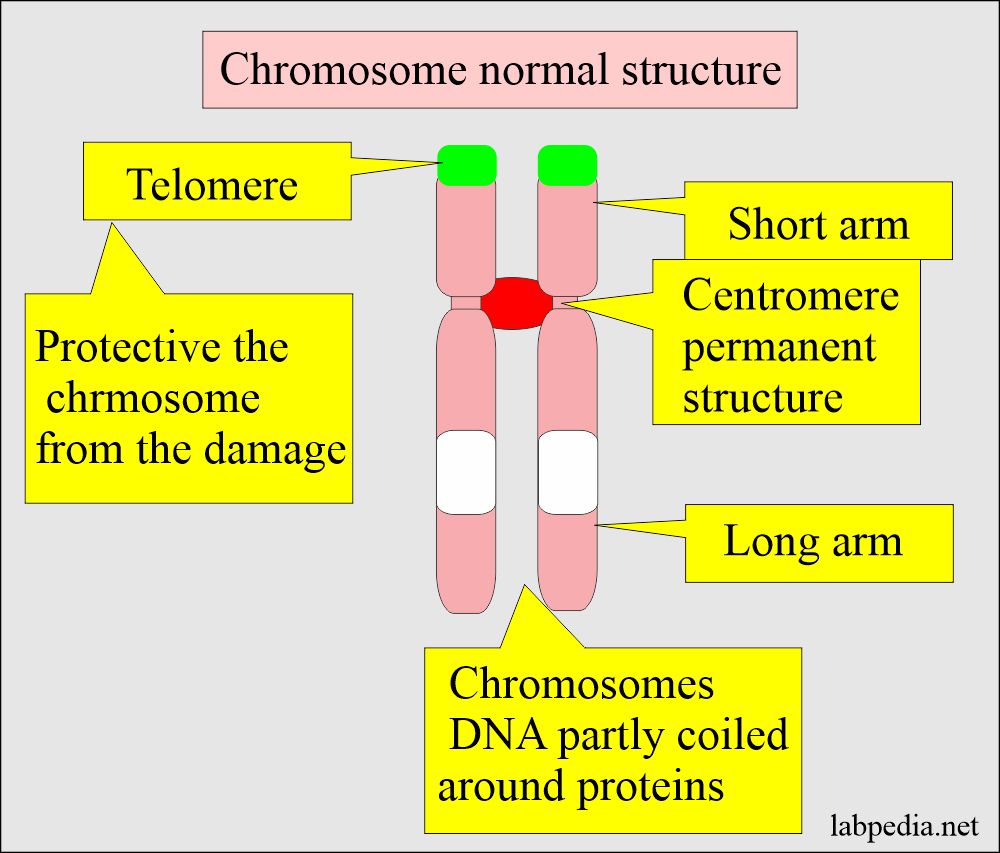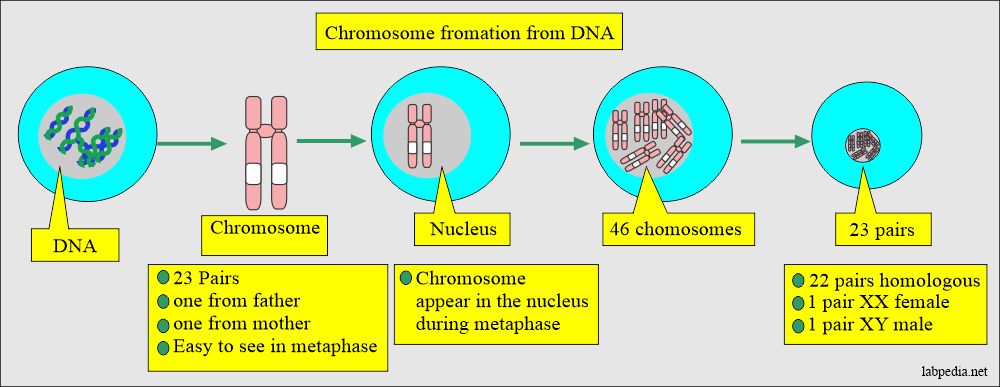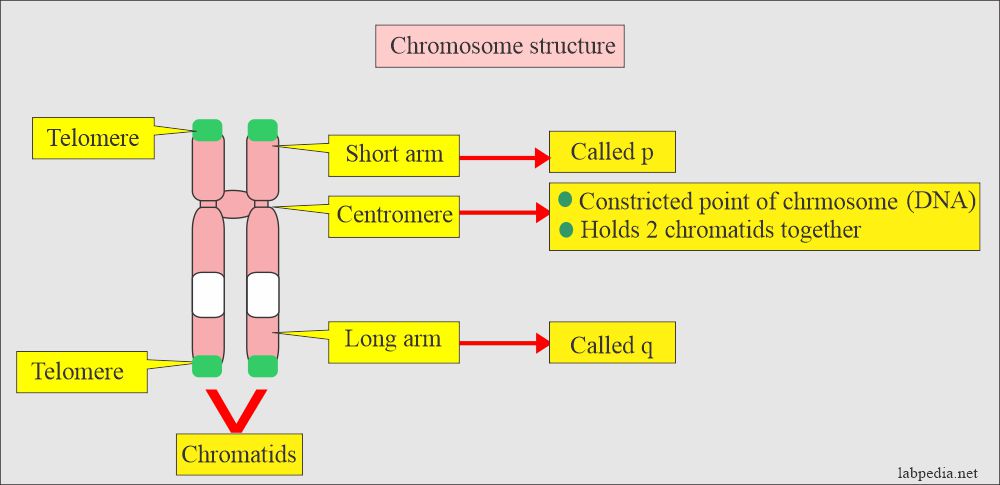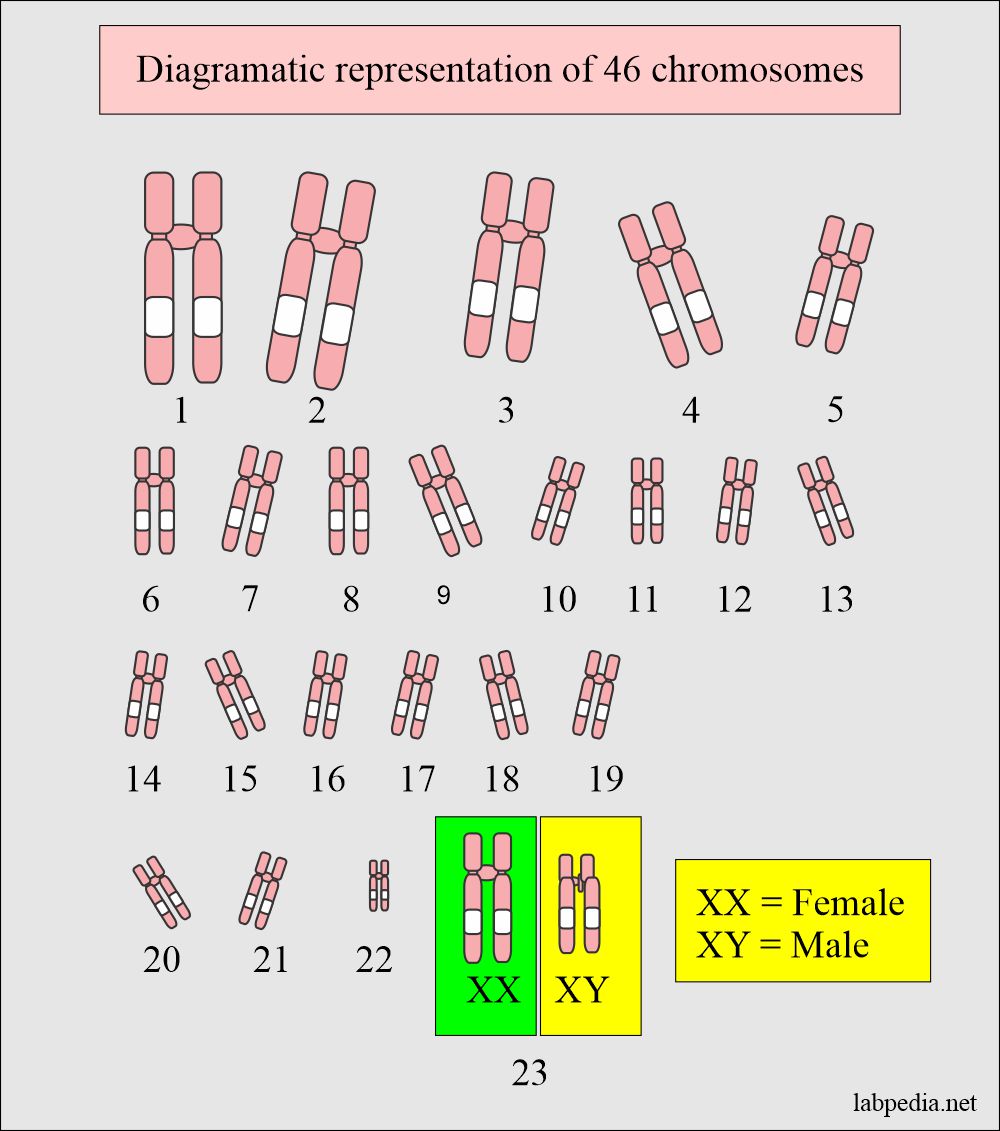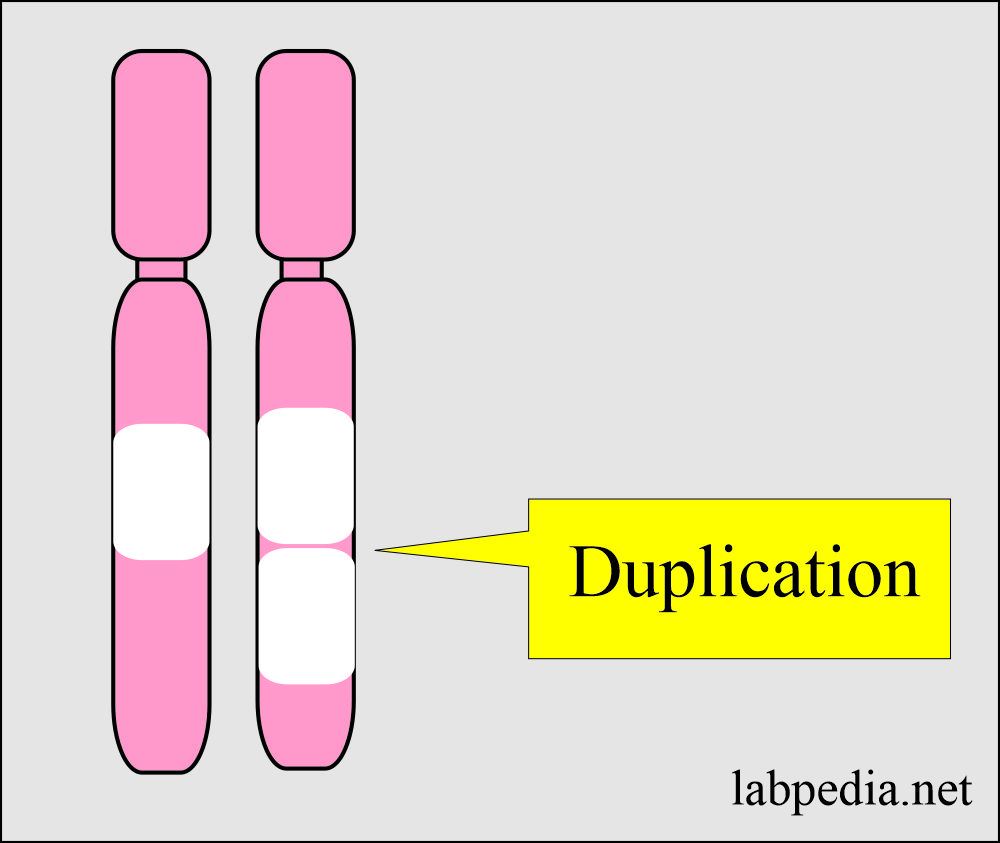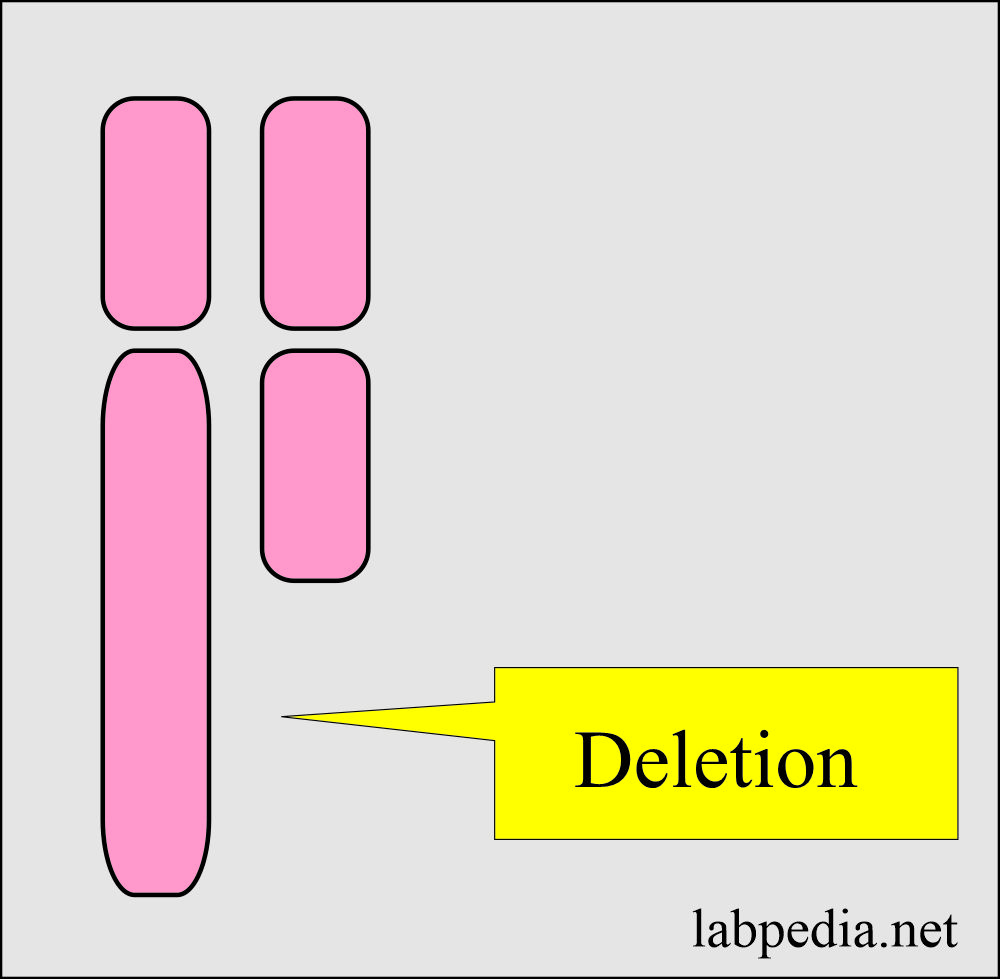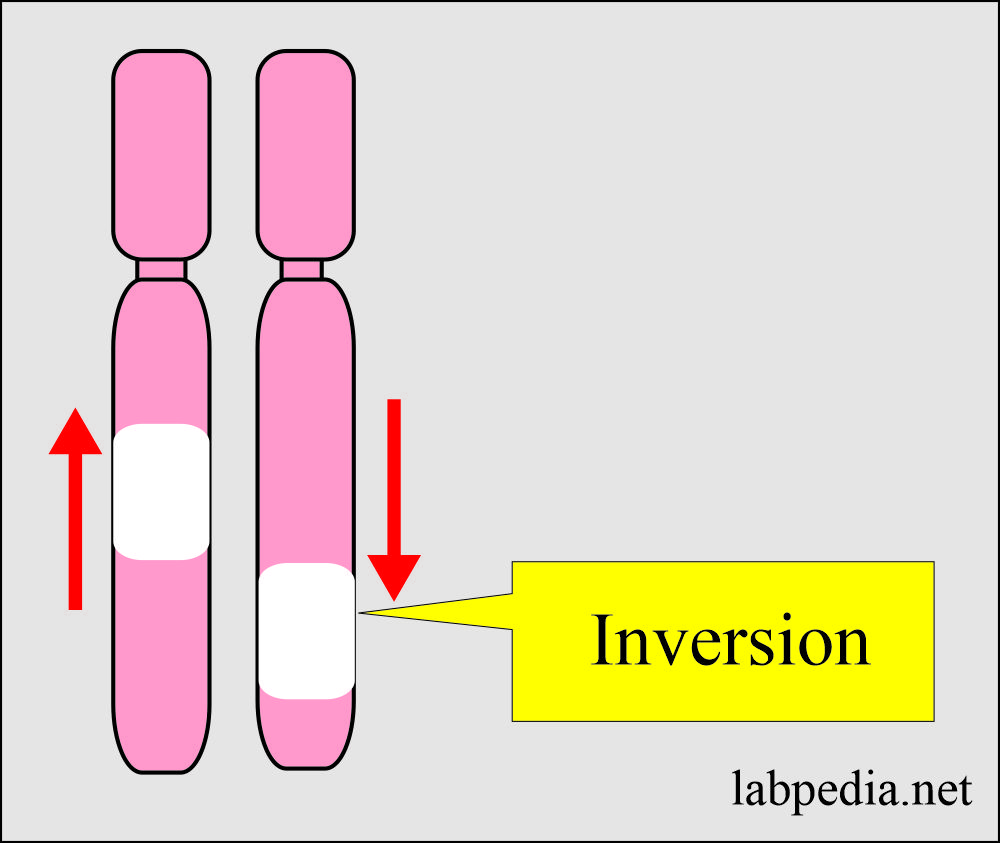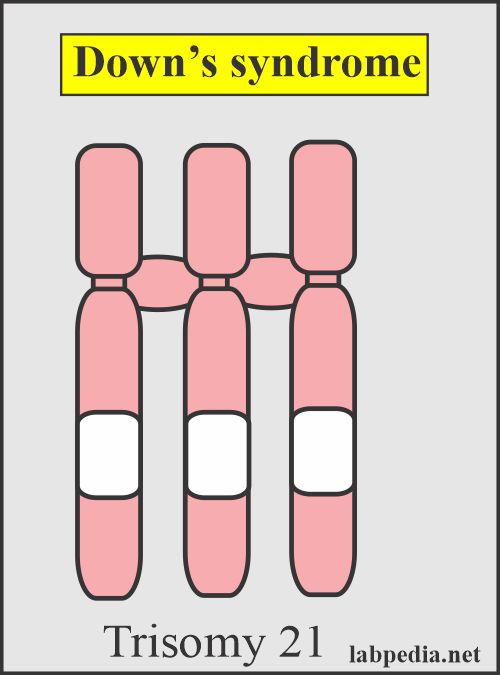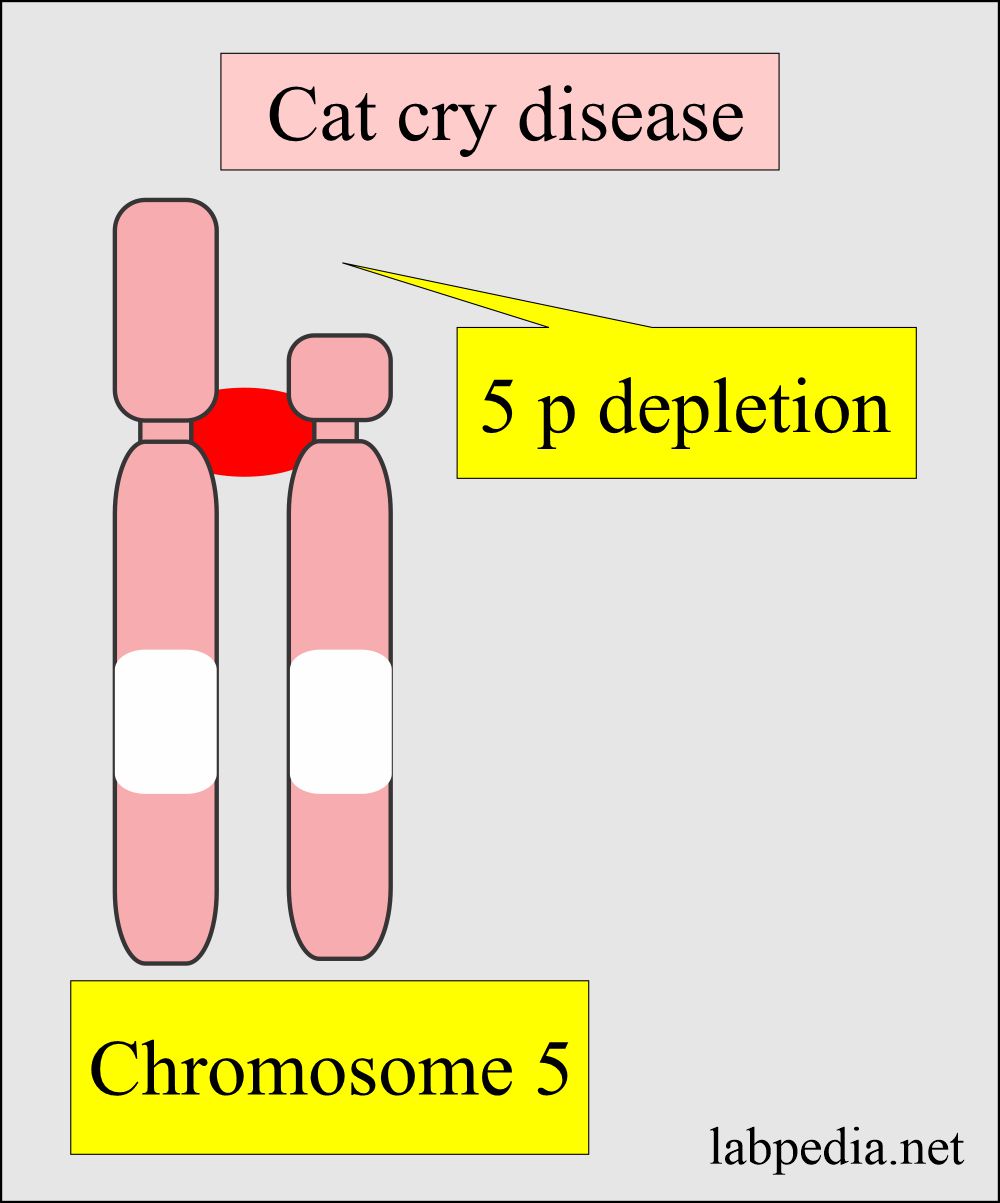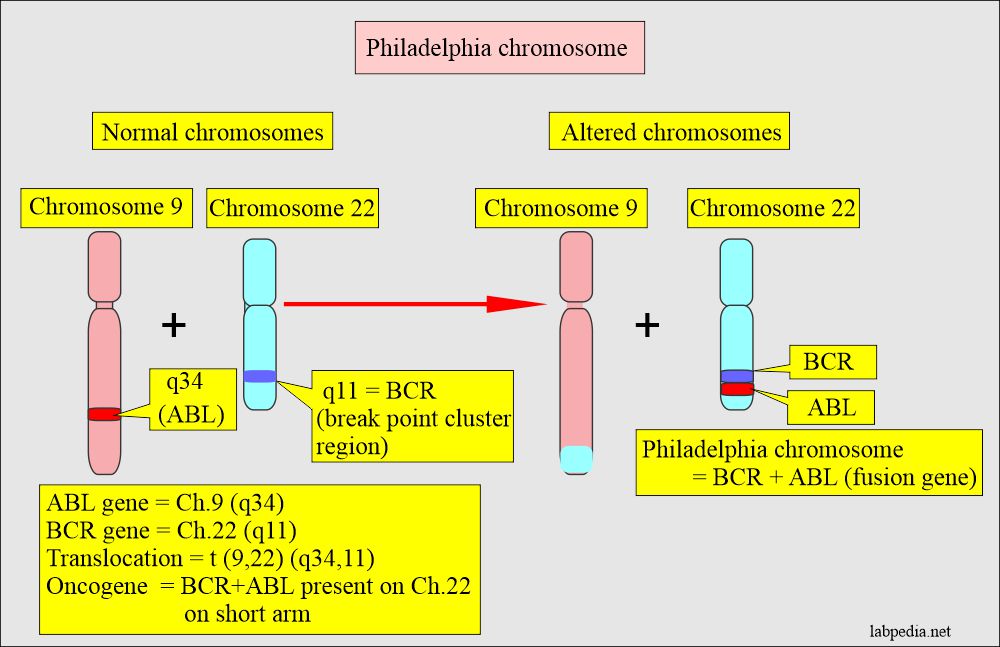Chromosome studies, Blood Chromosome Analysis, Cytogenetics, Chromosome Karyotyping
Chromosome studies
Sample for Chromosome studies
- The test can be performed on almost any tissue, including:
- Blood. Leucocytes are a good source and can easily get the sample from the vein.
- Bone marrow.
- Placenta.
- Amniotic fluid (amniocentesis).
- Chorionic villous sample.
- Smears from the buccal mucosa are accessible but not as good as other sources.
- Skin.
- Tumor cells.
Chromosomal karyotyping or chromosomal analysis (Indications):
- This test is done to find a chromosomal defect that may lead to or is a disease risk.
- Count the number of chromosomes.
- Look for structural changes in chromosomes.
- On a couple that has a history of miscarriage or infertility. Both parents need chromosomal studies.
- In the case of two consecutive abortions.
- When there is more than one organ abnormality in the infant.
- In the case of developmental delay, mental retardation, and growth retardation.
- To advise on ambiguous genitalia.
- In the case of mental retardation and or developmental delay when the cause is not known.
- In the case of the family history of chromosomal translocation.
- To examine any child or baby who has unusual features or developmental delays like:
- Mental retardation.
- Growth retardation.
- Delayed puberty.
- Hypogonadism.
- Primary amenorrhoea.
- Ambiguous genitalia.
- Neoplasm.
- Prenatal diagnosis of congenital disease.
- Turner syndrome.
- Klinefelter syndrome.
- Down syndrome.
- In the case of spontaneous abortion, stillbirth, and neonatal death.
- The bone marrow or blood test can identify the Philadelphia chromosome, which is found in about 85% of people with chronic myelogenous leukemia (CML).
- The amniotic fluid test is done to check a developing baby for chromosome abnormality.
- Advised in ladies over the age of 40 years (advanced age). In these ladies, prenatal chromosomal testing is done. 1 out of 400 has a greater risk for chromosomal abnormality, biochemical abnormality, or single gene anomaly.
- Tissue from the spontaneous abortus, stillbirth, or neonatal death to find the cause of death.
Effect of chromosomal abnormalities on pregnancy and fetus:
- There may be spontaneous abortion.
- 50% of the fertilized ova have some form of chromosomal abnormality, and >99% of these ova will die during gestation.
- There may be 50% chromosomal abnormalities in the fetus, and out of these,> 90% will die during the gestational period.
- 50% of abortions, 7% of stillbirths, and 0.5% of neonates have chromosomal abnormalities.
History of chromosomes:
- Strasburger first described chromosomes in 1815.
- Waldeyer used the chromosome term in 1888.
- Chromosomes appear in rod-shaped dark staining bodies during the metaphase stage of mitosis when cells are stained with special stains and can be seen under a light microscope.
Each human somatic cell has 46 chromosomes in pairs of 23 from each parent:
- These are diploid cells; the fetus gets one chromosome from each of the parents, one from the father, and one from the mother.
- It means the donation of one chromosome from each of the parents.
- 22 chromosomes are identical, called homologous (autosomes).
- One pair consists of XX in females and XY in males.
- Chromosome number 1 is the longest.
- Chromosome number 22 is the shortest.
- Chromosomes can not be distinguished by their length because of the variation from person to person.
- Therefore, the position of the centromere is used to classify chromosomes.
- Chromosomes are stained with the Giemsa stain, which gives distinctive chromosome bands.
Karyotyping:
- Karyotyping refers to the arrangement and pairing of cell chromosomes in order from the largest (longest) to the smallest (shortest) to analyze their number and structure.
- Karyotyping is the number and appearance of chromosomes in the nucleus of a eukaryotic cell.
- Karyotyping refers to the arrangement of cell chromosomes, their number, and structure.
- Karyotypes describe the number of chromosomes and their appearance under a light microscope.
- The normal karyotype of chromosomes consists of:
- 22 pairs of autosomal chromosomes (XX).
- One pair consists of a sex chromosome, XY for the male and XX for the female.
- The somatic cell with more or less than 46 chromosomes is called aneuploidy.
- More than 46 chromosomes are called hyperploidy.
- Less than 46 chromosomes are called hypoploidy.
Chromosomal abnormalities may be:
- Congenital.
- Acquired.
- Chromosome abnormalities are the common cause of mental retardation and miscarriage.
- Roughly 1 in 12 conceptions has a chromosomal abnormality.
- Most of these fetuses don’t survive to term, and 50% of first-trimester fetuses abort and have major chromosomal abnormalities.
- Karyotype (Chromosomal) abnormalities occur because of:
- Duplication.
- Deletion denoted by del. This may take place on the short or long arm.
- Translocation denoted by t.
- Reciprocation.
- Genetic rearrangement.
Normal chromosomes
- Females = 44 autosomes + 2 sex chromosomes (XX) = Karyotype = 46, XX
- Males = 44 autosomes + 2 sex chromosomes (XY) = karyotype = 46, XY
The procedure of chromosomal analysis:
- The cells are stimulated to divide.
- Lymphocytes can be stimulated by phytohemagglutinin.
- Add Colchicine to arrest the mitotic division.
- A hypotonic solution is added to spread out the chromosomes.
- Fixation is done by Carnoy’s solution.
- Now, put the cells on the slide.
- Cell membranes are ruptured, and chromosomes remain in well-defined groups.
Staining procedure:
- The chromosomes are stained by various staining agents like Giemsa or Fluorescent material.
- Giemsa banding (G banding) is the most common method for banding the chromosomes.
- The dark bands are rich in DNA bases adenine and thymidine.
- The light bands are rich in cytosine and guanine.
- Quinacrine banding (Q banding) is like Giemsa banding, and it is a fluorescent method.
- Karyotyping: Now, select cells with intact chromosomes.
- Chromosomes are counted, identified, and evaluated.
- This is the arrangement and pairing of cell chromosomes, starting from the largest to the smallest in size.
- Reporting: Count autosomal chromosomes, and these are numbered according to their size.
- The larger one is labeled as 1.
Reporting of Chromosomal analysis:
- Hyperploidy is an extra chromosome.
- Hypoploidy is when the chromosomes are missing.
Duplication
- It is when part of a chromosome is duplicated.
Deletion:
- It is when the part of a chromosome is missing.
- In addition, when the chromosome has the additional material.
- Insertion is when the part of a chromosome is repositioned into a different area of the karyotype.
Inversion:
-
- It is when the chromosome segment is reversed in orientation.
Mosaic:
- Mosaic is when some cells have an abnormal cytogenetic abnormality, whereas the other cells don’t have it.
Translocation:
- Translocation is when there is a balanced exchange of the chromosomes without any loss or gain of the material.
Chromosomal abnormalities and syndromes:
| Chromosomal abnormality | Disease or syndrome | Defect |
|---|---|---|
| Philadelphia | Chronic myelocytic leukemia | Ph t(9;22) and variants |
| t(6,9) | AML with basophilia | |
| t(3;3), inv(3) | AML with thrombocytosis | |
| Ph t(9;22) | B- cell ALL | |
| t(1;14) and variants | T-cell ALL | |
| t(8;14), t(2;8), t(8;22) | Burkitt lymphoma | |
| One X (45 XO) | Turner syndrome |
|
|
Klinefelter syndrome |
|
| Trisomy 21 (47XX, G+ or 47XY,G+ | Down’s syndrome |
|
| 5 p deletion | Cat Cry | |
| trisomy 18 | Edward’s syndrome | |
| Trisomy 13 | Patau syndrome | |
| Mutation 11 | Sickle cell anemia | |
| Hyperploidy | In some acute lymphoblastic leukemia | |
| Hypoploidy | In some myelodysplastic syndrome | |
| Trisomy 8 mosaic | Trisomy 8 syndrome | |
| Trisomy 22q 11-pter | Cat-eye syndrome | |
| 69, XXY | Triploidy | |
| Xq27.3 | Fragile X syndrome | |
| 47, XYY | XYY syndrome | |
| 47, XXX | Tripple X syndrome | |
| Xq13-21.1 sex-linked | Severe combined immune deficiency (SICD) | |
| Xp11-11.3 | Wiskott-Aldrich syndrome | |
| 11q 22.3 | Ataxia telangiectasia | |
| X q222 | X-linked agammaglobulinemia | |
| 6p21.3 | Selective IgA deficiency |
Questions and answers:
Question 1: What is the chromosomal abnormality in the Down's syndrome?
Question 2: What is the chromosomal abnormality in the Edward's syndrome.

